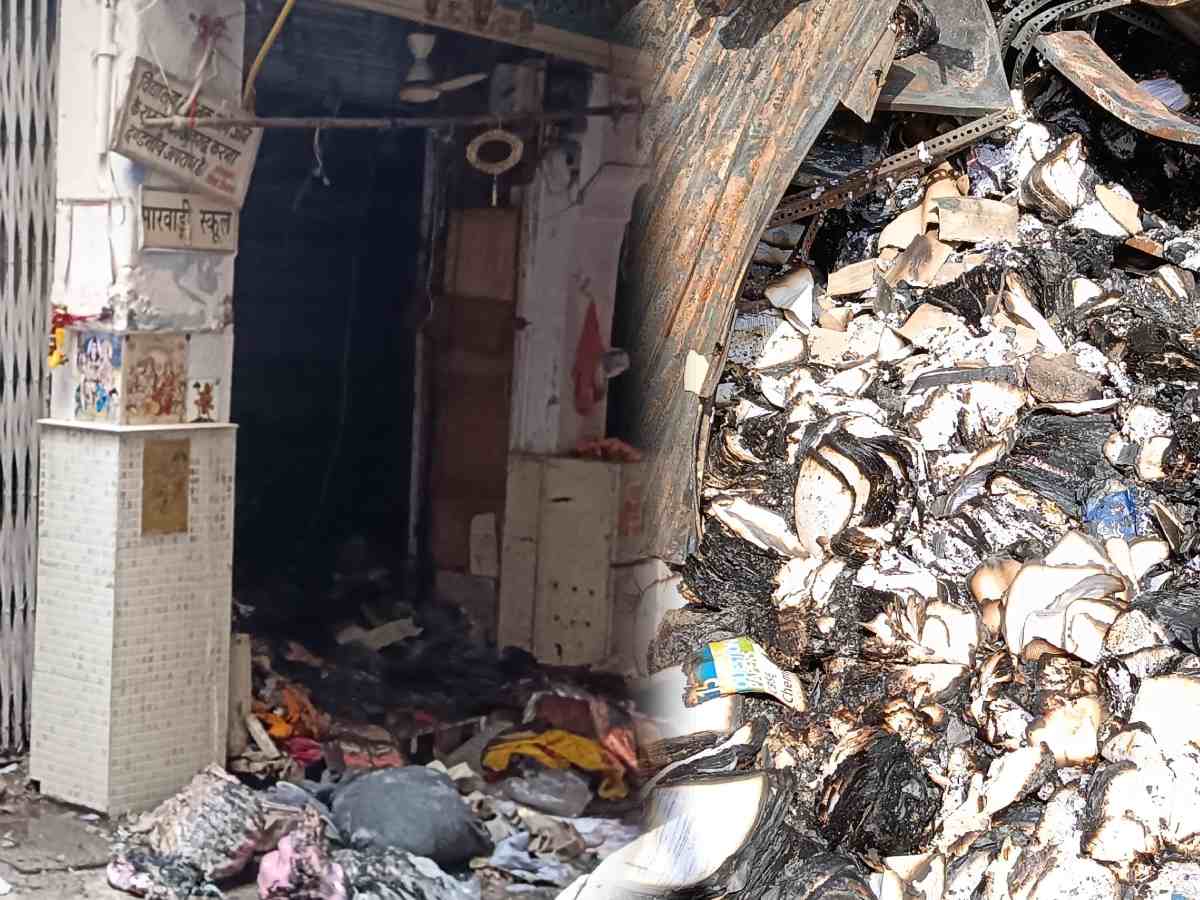Delhi: On June 13, as the shopkeepers inside Marwadi Katra went about their business as usual, they were all in for a rude shock as a blaze, which started abruptly, quickly spread through the marketplace. According to shopowners, 200 shops have been affected across the two markets within the Chandni Chowk establishment’s premises.
Business owners in Marwadi Katra, which houses over 500 shops, dubbed the blaze to be the worst case of fire they had seen unfold within the busy marketplace. Within Marwadi Katra’s cramped alleys, the smell of charred garments and burnt acrylic walls hung in the air days after the incident.
According to rough estimates by the shopowners, the losses suffered due to the fire run to the tune of several crores, without any discussion of compensation from the government.
| PROBABLE CAUSES OF FIRE |
| Overloaded meters |
| Short circuit |
| Twisted wires |
| Parallel electrical lines |
| Lack of space between shops |
| Inflammable substances |
Why did the building catch fire?
Many speculate that owing to narrow alleyways, haphazardly placed shops, and entangled power lines alongside a constant heavy load on the electrical infrastructure, a major fire was all but unavoidable. Thus, even after six days of trying to get the fire under control, the blaze continues to smoulder in pockets.
“We have been at it since June 13. The fire is still burning, it is under almost 15 feet of rubble, where water cannot reach. The blaze is under control, but it’s still taking a lot of time to get fully extinguished,” said Inderveer, the lead firefighter from Delhi Fire Services.
To put matters into perspective, the market houses several garment and hosiery stores and a few bookstores. The market complex has multiple markets inside with Amit Market and Bhagirathi Market being the most affected. It is in the former that the fire erupted and travelled to the latter. A significant part of the complex has been left untouched. However, much of the first, second and third floors of the complex have been left in absolute ruin.
Also read: Delhi: Extreme heat pushes power demand to an unprecedented high
The DFS official added that they had made over 150 rounds to the site, but the progress was still incremental.
The human cost of the fire has been acute with no end in sight to the misery of the storeowners who lost their possessions and source of livelihood. Several garment stores operate from within the market premises, where stealing electricity through a separate electrical meter box connected to the primary connection is not unheard of.
How the shopowners are coping
Chetan Agarwal, one of those who lost their shops in the fire, was devastated. He said, “I have been running the shop for as long as I can remember. It was handed down to me by my father. I did not have all of my wares inside my store since a significant part of my inventory is stored inside my godown, which has saved me from absolute ruin but I still cannot function out of my store. I do not know how long I can make my savings last.”
However, workers are the most affected section of those affected by the blaze. Shaqib Hassan, 42, said that he had lost all hope of sustaining himself and his family. “I do not have any savings. I have a family of four and we were mostly living hand to mouth. We were happy but the income was not enough for a comfortable life, but now the entire scenario has changed. I do not know from where I will get the money to survive for the month. I will have to take up another job or several odd jobs if my employer chooses to not support me,” he said.
Many of the workers at the market were provided considerably less salary than the minimum wage in the national capital. According to the Chief Labour Commissioner’s office, the minimum wage of Rs 17,494 is guaranteed to all unskilled workers in Delhi. However, of the employees working at these shops, most were getting a monthly wage of Rs 10,000, without any benefits. Thus, after the destruction of the entire market, these labourers have been left to fend for themselves.
| OTHER RECENT FIRE INCIDENTS | ||
| June 18 | Shahdara factory | No casualties |
| June 15 | Vasant Vihar market | 5 shops destroyed, no casualties |
| June 13 | Marwadi Katra | 200 shops gutted, no casualties |
| June 9 | Shaheen Bagh 40 feet road | 3 restaurants, 2 shops and multiple flats affected, no casualties |
| June 5 | Eye 7 Chaudhary Eye Hospital, Lajpat Nagar | No casualties |
| May 25 | Baby Care New Born Hospital, Vivek Vihar | 7 infants dead, 5 injured |
Sharad Balani, another owner of a smaller shop at Bhagirathi market, claimed that it was the bigger shops which would get parallel lines and put an immense load on our electrical supply. “It’s a lot of work surviving beside the bigger shops. The shopowners are immensely egotistic. They do not think about the others who are working inside the same premises. I had warned them that if they kept stealing electricity, the wires would not be able to bear the load. What I had warned about has eventually happened and I have lost my shop in the wake,” he said.
Rakesh Gupta, a wholesale merchant of women’s garments, said that all of the shopkeepers who had their shops on the ground floor had their shops filled with inflammable substances. “Honestly, the entire market is filled with inflammable substances, which include all kinds of clothes, and sometimes, some of us keep garments made of nylon too, which makes it very easy for them to catch fire. On the other hand, short circuits are not that uncommon here, but they are always controlled, so that has never had an impact, but this time, we think that it may have been the primary cause behind the market catching fire,” he said.
What is the Delhi Fire Services’ plan of action
Atul Garg, the Delhi Fire Services chief, said that the national capital had become witness to many more fire incidents this time around owing to an extended heatwave and immense pressure on electrical supply. “In summer, the risk of fires increases due to overheated electrical wires and appliances causing short circuits. These can spark and ignite nearby flammable materials, especially when temperatures strain electrical systems, making wires more likely to overheat,” he said.
Recurrent issue of fire incidents
On June 18, another fire incident took place at a factory in Shahdara without any casualties. Vasant Vihar also witnessed a massive fire, which resulted in five shops at the market being gutted, as ten fire tenders reached the spot. On the other hand, another restaurant in Shaheen Bagh also bore the brunt of the fire calamity, as 18 tenders reached the spot to put the fire out. All these incidents happened in June.
On the other hand, earlier in May, East Delhi’s Vivek Vihar was victim to a massive fire that razed down an entire hospital for babies, resulting in the death of seven babies, with five being severely injured. Similarly, in June, an eye hospital at Lajpat Nagar also paid the price of an overloaded AC, which sparked a blaze.
Following the fire, Lok Sabha MP Praveen Khandelwal said, “The negligence of BSES and the Delhi government is responsible for the losses. They must compensate the traders. It’s shocking that none of the newly installed fire hydrants on main Chandni Chowk were working, forcing fire brigades to travel long distances to bring water to the site.”





